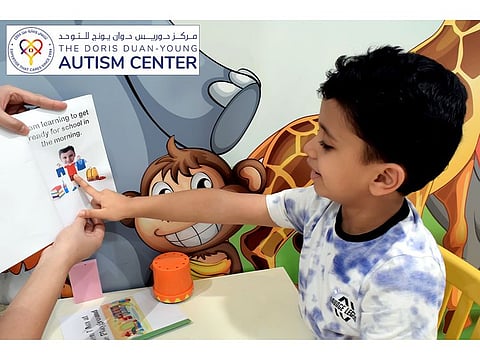Transitioning a child from one activity to another
Applied Behaviour Analysis strategies that can help

There are many times each day when your child has to stop doing one activity and begin to do something else. Examples include: going home after playing at the park, turning off iPad or television before bedtime, getting them out of the pool to have lunch, getting out of the car to go home and a lot more. For most children, transitions between activities make them feel frustrated but this may be a lot harder for People of Determination as it is a very common trigger for challenging behaviours.
According to B.F. Skinner who is known as the father of Behaviour Analysis, “properly used positive reinforcement is extremely powerful”. Providing the right Applied Behaviour Analysis (ABA) such as positive reinforcement to your child may help facilitate a smooth transition. Furthermore, when we speak about transitioning from a preferred activity to a non-preferred activity, various antecedent ABA strategies can be utilise to help support you and your child in transitions.
What is transition all about and how is it related to individuals with Autism Spectrum Disorders (ASD)?
People of Determination especially those diagnosed with ASD typically struggle when it comes to transitions because not knowing what is next is stressful and routine is more preferred. It is challenging for them to move from one activity to another, start a new task, or even end an existing activity. A change in routine or a disruption in an existing activity typically results in challenging behaviours (i.e, tantrums, refusal, shouting etc.). One of the ways to avoid this cycle is to implement some of the ABA strategies that will be outlined in this article.
Here are few Antecedent (Preventative) Strategies that The Doris Duan-Young Autism Center (DDY) is implementing that helps create a smooth transition:
1. Visual Schedule Boards
On a regular basis, all therapists at DDY follow a schedule – not only their own work schedule but also for the children they work with. Following a schedule comes in many forms but the most common for children with ASD is a Visual Schedule Board. Visual Schedule Boards contain specific pictures of different activities that they will have throughout the day. For children that can read a visual schedule can be accompanied with the words of the activities instead of a picture. For higher functioning children, they may be asked to write down their own schedule to follow for the day. In any case, this helps establish a routine to follow and gives an overview on what to expect during the day in order to prevent the fear of the unknown. A visual schedule can be more effective if you provide your child with choices (when applicable) so they feel empowered that they have decided on what their schedule will look like.
2. First and Then Board
First and Then Board is a visual tool to support transition as the learner is aware of the activities. This strategy is based from Premack’s Principle – where a person’s motivation to complete a less preferred activity increases when followed by a more preferred activity.
3. Social Stories
Social stories are individualised short stories that gives children with ASD an outline of a social situation that your child may have difficulty with (i.e., getting ready for school, transitioning from one activity to another, greeting a friend etc.). Social Stories are an effective teaching tool that is typically written in first person or the child’s point of view and usually in present tense. This way when you read it with the child or they read it for themselves they have a clear depiction of the behavioral expectation of the specific skill.
In The Doris Duan-Young Autism Center (DDY), the center encourages a more nurturing environment and provides variety of strategies to support People of Determination cope with changes in their environment and daily activities. DDY team are all well trained with evidence-based strategies to make transitioning less aversive and easier for the therapists, parents and children.
If you are a parent to a child who is in the same situation, you are more than welcome to inquire and visit in DDY to seek top-notch therapy assistance that your child needs.
Sign up for the Daily Briefing
Get the latest news and updates straight to your inbox



